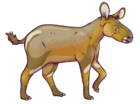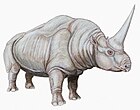Anthracobune
Appearance
| Anthracobune Temporal range:
| |
|---|---|

| |
| Life restoration | |
| Scientific classification | |
| Domain: | Eukaryota |
| Kingdom: | Animalia |
| Phylum: | Chordata |
| Class: | Mammalia |
| Family: | †Anthracobunidae |
| Genus: | †Anthracobune Pilgrim 1940 |
| Species[1] | |
| |

| |
| The inferred range of Anthracobune | |
Anthracobune ("coal mound") is an extinct genus of stem perissodactyl from the middle Eocene of the Upper Kuldana Formation of Kohat, Punjab, Pakistan.[2]
The size of a small tapir, it lived in a marshy environment and fed on soft aquatic plants. It is the largest-known anthracobunid. This group was formerly classified with proboscideans.
Notes
[edit]- ^ Cooper, Lisa Noelle; Seiffert, Erik R.; Clementz, Mark; Madar, Sandra I.; Bajpai, Sunil; Hussain, S. Taseer; Thewissen, J. G. M. (2014-10-08). Farke, Andrew A. (ed.). "Anthracobunids from the Middle Eocene of India and Pakistan Are Stem Perissodactyls". PLOS ONE. 9 (10): e109232. Bibcode:2014PLoSO...9j9232C. doi:10.1371/journal.pone.0109232. PMC 4189980. PMID 25295875.
- ^ "Fossilworks: Anthracobune". fossilworks.org. Retrieved 17 December 2021.
References
[edit]- Kumar, Kishor (1991). "Anthracobune aijiensis nov. sp. (Mammalia: Proboscidea) from the Subathu Formation, Eocene from NW Himalaya, India". Geobios. 24 (2): 221–39. Bibcode:1991Geobi..24..221K. doi:10.1016/s0016-6995(91)80010-w. OCLC 4656806310.
- Pilgrim, Guy E. (1940). "Middle Eocene mammals from north-west Pakistan". Proceedings of the Zoological Society. B. 110. London: 127–152. doi:10.1111/j.1469-7998.1940.tb00029.x.
- Sahni, Ashok and Kumar, Kishor (1980). "Lower Eocene Sirenia, Ishatherium subathuensis, gen. et sp. nov. from the type area, Subathu Formation, Subathu, Simla Himalayas, H. P." (PDF). Journal of the Palaeontological Society of India. 23&24: 132–5. Retrieved 1 July 2013.
- Wells, Neil A. and Gingerich, Philip D. (1983). "Review of Eocene Anthracobunidae (Mammalia, Proboscidea) with a new genus and species, Jozaria palustris, from the Kuldana Formation of Kohat (Pakistan)" (PDF). Contrib. Mus. Pal. Univ. Michigan. 26 (7): 117–139. OCLC 742731409.









